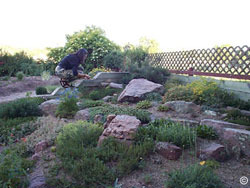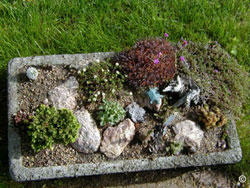Many fall in love with the spectacular flowers in the Rocky Mountain tundra and want to grow some at home. Rock gardens mix flowers and the ruggedness of the mountains.

To begin a rock garden, select a spot that is open to light but is not too hot. An east facing bank or berm is ideal. Soil generally must be amended, or mixed with organic material, to make it porous. A mix of half native topsoil and equal parts coarse sand, pea-sized gravel and compost is one common recipe used by rock gardeners.
 Don’t be afraid to be expressive. Rock gardens look best when they are bold and large, rather than puny and trivial. The rocks should all be of the same source, but of different sizes. Avoid placing them regularly or jumbling them randomly. The placement of rocks is an art and beginning rock gardeners should look up some books on the subject, spend a little time observing outCrops in nature, and try visiting successful rock gardens to see how others have done it. Rock gardens are usually included on the major garden tours in this area, and there is a large and active chapter of the North American Rock garden Society, which can also be a resource.
Don’t be afraid to be expressive. Rock gardens look best when they are bold and large, rather than puny and trivial. The rocks should all be of the same source, but of different sizes. Avoid placing them regularly or jumbling them randomly. The placement of rocks is an art and beginning rock gardeners should look up some books on the subject, spend a little time observing outCrops in nature, and try visiting successful rock gardens to see how others have done it. Rock gardens are usually included on the major garden tours in this area, and there is a large and active chapter of the North American Rock garden Society, which can also be a resource.
A mulch of gravel or a stone a similar color to the rocks in the garden will trim a rock garden beautifully. Remember, a rock garden is not designed for immediate impact. It will look sparse in its first year so plant lots of tiny spring bulbs. You will be rewarded for years to come with this sophisticated garden art form.
For “Xeriscape mulches” refer to message 1905.
For more information, see the following Colorado State University Extension fact sheet(s).
- Mulches for Home Grounds
- Xeriscaping: Creative Landscaping
- Wildflowers in Colorado
- Choosing a Soil Amendment
- Rock garden Plants
- Spring-Planted Bulbs, Corms and Roots



